
Walter Burley Griffin was an American architect and landscape architect. He designed Canberra, Australia's capital city, the New South Wales towns of Griffith and Leeton, and the Sydney suburb of Castlecrag.

Lake Burley Griffin is an artificial lake in the centre of Canberra, the capital of Australia. It was completed in 1963 after the Molonglo River, which ran between the city centre and Parliamentary Triangle, was dammed. It is named after Walter Burley Griffin, the American architect who won the competition to design the city of Canberra.

Old Parliament House, formerly known as the Provisional Parliament House, was the seat of the Parliament of Australia from 1927 to 1988. The building began operation on 9 May 1927 after Parliament's relocation from Melbourne to the new capital, Canberra. In 1988, the Commonwealth Parliament transferred to the new Parliament House on Capital Hill. It also serves as a venue for temporary exhibitions, lectures and concerts. Old Parliament House is, looking across Lake Burley Griffin, situated in front of Parliament House and in line with the Australian War Memorial.
The National Emergency Services Memorial is a memorial located on the northern shore of Lake Burley Griffin at the southern end of Anzac Parade in Canberra, the national capital of Australia. It was dedicated in July 2004.
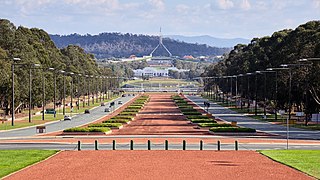
Anzac Parade is a significant road and thoroughfare in the Australian capital Canberra, used for ceremonial occasions and the site of many major military memorials.
The Australian–American Memorial is in Canberra, the national capital of Australia, and commemorates the help given by the United States during the Pacific War.

The Hellenic (Greek) Memorial is on Anzac Parade, beside the Australian War Memorial in Canberra, the national capital city of Australia.
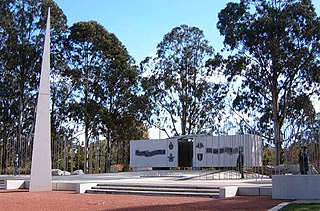
The Australian National Korean War Memorial is on Anzac Parade, the principal ceremonial and memorial avenue in Canberra, the national capital city of Australia.
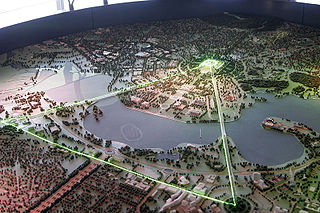
The National Triangle, which is referred to as the Parliamentary Triangle, is the ceremonial precinct of Canberra, containing some of Australia's most significant buildings. The National Triangle is formed by Commonwealth, Kings and Constitution Avenues. Buildings within the National Triangle have been located and designed intentionally for visual effect, and those of national significance are popular tourist attractions.

Commonwealth Place is located on the southern shore of Lake Burley Griffin, Canberra. It lies along the ‘water axis’ running along the lake from Black Mountain. Commonwealth Place is the location of the Gallery of Australian Design, Reconciliation Place, a restaurant and Speakers Square. Walter Burley Griffin, the architect who designed Canberra, envisaged that the area would be the site of a "water gate" which would have a terrace above it, providing a "forum for the people". Griffin's vision was for a long time left unrecognised but as of 2005 the area was being developed to reflect the original plan.

Kings Park is a park in Canberra, Australia on the shore of Lake Burley Griffin.
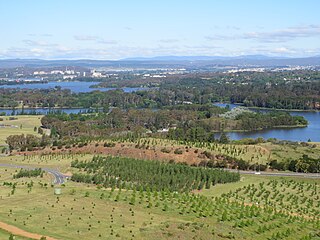
Yarramundi Reach is a small peninsula on the western end of Lake Burley Griffin, in the Australian Capital Territory, close to Scrivener Dam. It is also the name for the area of water on Lake Burley Griffin between it and Weston Park.
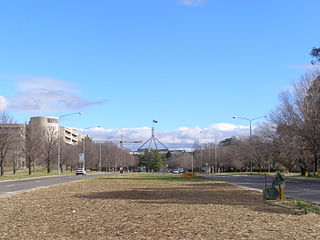
Kings Avenue is a road in Canberra which goes between New Parliament House, across Lake Burley Griffin at the Kings Avenue Bridge, to Russell near the Australian-American Monument..
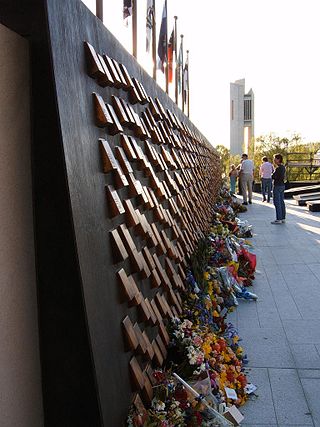
Australia's National Police Memorial is in the national capital, Canberra, in King's Park on the northern shore of Lake Burley Griffin adjacent to the National Carillon on Aspen Island. It commemorates Australian police who have died on duty.

The history of Lake Burley Griffin, an artificial body of water in Canberra, the capital of Australia, is highly complex. Following its initial design in the 1910s, extensive political disputes occurred until it was finally built in the 1960s.

Sullivans Creek, a partly perennial stream of the Murrumbidgee catchment within the Murray–Darling basin, is located in Canberra, Australian Capital Territory, Australia.
The Immigration Bridge was a proposed footbridge in Canberra, the capital of Australia. It was proposed that it be built between the National Museum of Australia and Lennox Gardens on the south shore of the West Basin of Lake Burley Griffin, in the centre of the city.

The Acton Peninsula is located on the northern shore of Lake Burley Griffin, in the centre of Canberra, the capital of Australia.

The National Workers Memorial in the national capital, Canberra, Australian Capital Territory, is Australia's place for honouring workers who have died as a result of work-related accidents, incidents and disease.
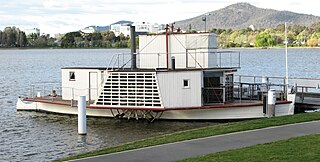
PS Enterprise is an 1878 Australian paddle steamer, currently owned by the National Museum of Australia in Canberra. It is still operational, and one of the oldest working paddle steamers in the world. It is listed on the Australian Register of Historic Vehicles.


















